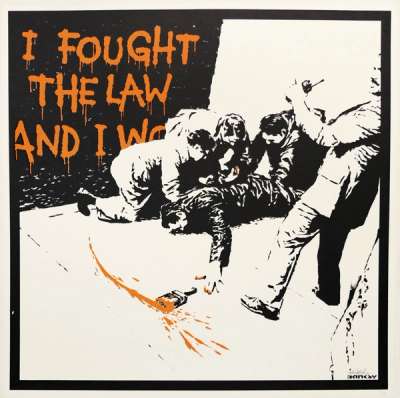Banksy's Pantomime Horse

 Pantomime Horse © Banksy 2005
Pantomime Horse © Banksy 2005
Banksy
269 works
Banksy's Pantomime Horse is a quintessential example of the artist's ability to engage with art historical discourse while maintaining his signature spirit and wit. The work features a British royal guard – a symbol of national pride, stoicism, historical continuity and discipline – in an unexpected alliance with a pantomime horse, rendered in a photorealistic and painterly style that juxtaposes the traditional with the contemporary and the authoritative with the absurd. The pantomime horse, known for its role in traditional British slapstick theatre, undermines the seriousness and authority of the guard, suggesting that the power structures we take for granted are as constructed and performative as theatre.
Pantomime Horse: Meaning & Analysis
This work is a visual pun that speaks volumes about Banksy’s belief in authority's inherent absurdity when considered within everyday contexts.
His art has consistently challenged notions of power, particularly those associated with the police and military, often doing so through a lens of subversive humour. Pantomime Horse exemplifies this approach, utilising the format of traditional oil painting to craft a piece that is at once familiar and jarringly incongruous. The guard invites viewers to reconsider the constructs of control, while the artist offers a critique of the historical and contemporary militarisation of British society. The playful yet pointed nature of the piece invites viewers to question the status quo, encouraging a reevaluation of authority’s manifestations in society. Banksy's art becomes a platform for social critique, using irony to challenge and provoke. The active engagement that Banksy demands from viewers underscores the democratising aspect of Banksy's art: it is accessible and thought-provoking, bridging the gap between the elite art world and the general public sphere.
Encased in a seemingly playful yet provocative visual narrative, this piece was a standout within the Crude Oils series, wherein Banksy ingeniously hijacked traditional oil paintings, integrating his disruptive figures into compositions that would otherwise belong to the canon of Old Masters. The inclusion of figures into classical-style works serves as a nod to Marcel Duchamp's "readymade" and the Pop Art movement's emphasis on mass production and appropriation, while also commenting on the pervasive influence of historical narratives on contemporary culture. As such, Banksy situates his work within a long tradition of artistic innovation and critique, questioning the role of the artist in society.
“This work demonstrates Banksy's genius in using familiar imagery in subversive ways to provoke thought and question the status quo.”

Crude Oils: Banksy vs. Art History
Banksy's Crude Oils exhibition was a groundbreaking show that ran for about a week in a small shop in Notting Hill at 100 Westbourne Grove, and today stands as a pivotal moment in the artist's career as he gained increasing recognition. Described as a "Gallery of re-mixed masterpieces, vandalism, and vermin," Banksy’s first UK gallery exhibition featured 20 re-invented classical oil paintings and was distinguished by the unconventional presence of around 200 live rats, along with unique sculptures. This melding of high art with elements of the everyday and the disruptive encapsulates Banksy's approach to art as a form of social commentary, challenging traditional art norms and expectations.
Similarly to Panto Horse Guard, the core of Crude Oils was the transformation of traditional oil paintings—sourced from flea markets around London—into contemporary critiques of social decline. By integrating motifs like burnt-out cars, police incident signs, and modern technology into idyllic landscapes and historical portraits, Banksy juxtaposes the serene with the chaotic, disrupting the viewer's expectations and prompting a reflection on the impact of modern society on our perception of beauty, history, and value. The exhibition also featured "vandalised" classical sculptures, such as a Venus adorned with a traffic cone and full-body tattoos, further Banksy's exploration of contrast and contemporary critique. These alterations of classical beauty standards and symbols of cultural heritage with modern, often jarring elements, question the permanence of art and its relevance to current societal issues.
While Crude Oils was Banksy's first "conventional" show, it broke all conventions with its interactive element and anti-establishment tone. Perhaps the most unconventional aspect was the inclusion of the live rats, which turned the gallery into a living, breathing representation of the artist's anti-establishment message. Rats, often seen as pests, here become part of the art as Banksy praises their resilience and survival. Their presence in the gallery space blurs the lines between art and life, inviting visitors to engage with the art in an immediately physical and visceral way. The inclusion of live rats and the thematic focus on social decline through the modification of classical artworks underscore Banksy's commitment to challenging the establishment.
Pantomime Horse: Exhibition History
Crude Oils, London, 2005



















